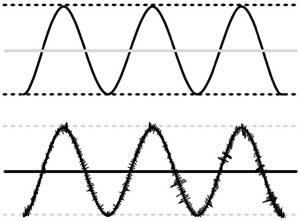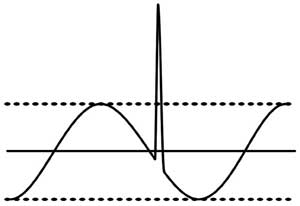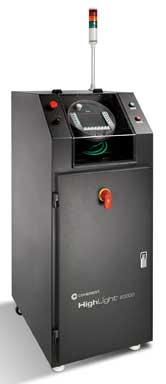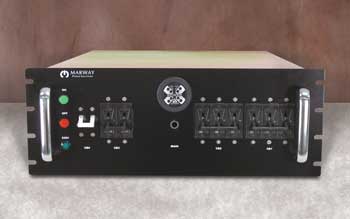Dave Proli, Marway Power Solutions
Electrical power is vital to a laser’s operation. Power quality, availability and distribution play a vital role in the laser’s performance. Laser manufacturers must consider these factors when designing new systems.
Lasers are precise instruments, and all components – internal or external – must meet exacting requirements. This includes the power supply.
Today’s power distribution units (PDUs) offer a wide array of options to meet the strict specifications of laser systems. Thanks to technology advances, product designers and integrators can choose from standard off-the-shelf units, commercial off-the-shelf (COTS) units, and COTS-modified or custom solutions designed for specific applications. For CO2, direct-diode, excimer, fiber-based and other laser systems, selecting the right power distribution scheme is essential to overall performance, longevity and uptime.
Laser systems need clean power
Stable power free of noise is paramount for laser systems to perform optimally and reliably. A clean AC signal has a perfectly smooth sine wave (Figure 1) when viewed on an oscilloscope. Any imperfections in this signal can adversely affect laser equipment, causing poor performance, incorrect functionality or even damage to sensitive circuitry.

Figure 1. Signal conditioning of AC power seeks to ensure as close to a perfect sine wave in the voltage signal as possible. The upper waveform has no noise, whereas the lower one is quite noisy. Courtesy of Marway Power Solutions.
Mobile power sources and power utilities in some developing nations will not deliver clean signals. Even the clean power supplied by a developed nation’s power utility will become degraded within a facility. This degradation is caused by the very devices that use the power, such as air conditioners and compressors; electric heating equipment; motor-driven industrial machinery; elevators and conveyors; computers, printers and copy machines; and ballasts for fluorescent lights.
Because signal problems are introduced to power lines throughout a facility’s wiring, it is beneficial to add power conditioning at points throughout the facility. An effective place to do this is at power distribution points near the end-use equipment with a PDU. Several problems exist that can affect a voltage signal. The most severe is a complete loss of power for short- or long-term durations. Similarly, significant periods of excessively low or high voltage are also a problem. Solutions generally are too large or specialized to integrate within a near-point-of-use PDU and are best applied as external complements.
Most other conditioning problems involve various forms of high-voltage surges (aka spikes) and electromagnetic interference (EMI), also known as electrical noise, or just noise. The solutions to minimizing these signal problems are well suited to the integration within a PDU.
Voltage spikes
Spikes commonly come from power-switching equipment such as circuit breakers or contactors, or from other causes. Less common sources include short circuits, static electricity, lightning and even large electromagnetic fields. While spikes are short, the increased voltage for even that short time may be enough to damage a laser’s microelectronic components and/or to cause malfunctions.
Voltage spikes are counteracted with surge protection devices (or surge suppressors). Surge protectors typically divert excess voltage from the protected power line straight to the ground, although there are other techniques. There are a variety of technologies to choose from, each with advantages for particular power environments.

Figure 2. A voltage spike may have a very high value, up to several thousand volts, but the duration is on the order of microseconds.
A voltage spike (Figure 2) may have a very high voltage value, up to several thousand volts, but the duration is on the order of microseconds.
Electromagnetic interference
Electromagnetic interference is a broad term covering multiple causes, the net effect of which is that electromagnetic waves of a wide spectrum of frequencies cause interference with the power signal. This noise on an AC power line causes deviation in the signal from the desired perfect sine waveform.
EMI can be classified in several ways. One way is to identify how interference gets into the power line, which includes conduction, capacitive coupling and induction. Another way is to address the frequencies being added to the signal. Radio-frequency interference (RFI) identifies a subset of frequencies common to communications and other equipment.
A third distinction is identifying common-mode and differential-mode noise. Common-mode noise manifests identically on multiple power conductors where the noise signal flows in the same direction, in phase, and typically returns through ground. Differential-mode noise occurs when the noise on each power line is not identical. Here, the noise signal flows through one power line and returns through another.
The primary defense for reducing inducted noise is shielding. This is commonly, but not exclusively, done to mitigate RFI. Cables and components are encased in metal, and they may require additional RFI gaskets with significant design detail to eliminate all air gaps. The remaining noise types can be reduced through EMI filters and isolation transformers. Filters use a combination of capacitors and inductors to block or divert frequencies outside the 50 or 60 Hz of the power signal. Isolation transformers provide good reduction of common-mode noise and allow an isolated ground that can offer significant benefits in noise reduction on downstream power lines connected to the PDU.
Power conditioning integration
Surge protection devices, EMI filters, isolation transformers and shielding are power conditioning strategies well suited to integration within PDUs. Adding these capabilities helps isolate sensitive laser equipment connected downstream of the PDU from the noise created by upstream power consumers. When an integrated solution is needed, work with the PDU manufacturer to identify:
• The appropriate size surge suppression device
• EMI filters to address application-specific or general-purpose frequency bands of common-mode and differential-mode noise
• Unique details to control the performance of isolation transformers
• Power capacity and packaging efficiency
• Any special weight, space or environmental conditions
When only a custom solution will work
Often times a PDU becomes an integrated component of an overall system (Figure 3). As an example, laser manufacturer Coherent Inc. needed a PDU that would house most of the power distribution, conditioning and control components inside a single chassis to enable easy integration into a new direct diode laser during manufacturing. Besides needing to be field-replaceable and to run on various international facility voltages, the PDU had to provide the desired output power.

Figure 3. The HighLight 8000D-series direct diode laser from Coherent Inc. requires a high-capacity PDU that can be integrated within the laser control unit.
Although the laser required high-capacity power from two PDU outputs, it also required clean, conditioned, low-capacity power from one output to run the intelligent controller for the laser system. The high-capacity outputs had to be managed by a fail-safe emergency power off (EPO) circuit so the laser system could be shut down in an emergency without disrupting the controller. The PDU (Figure 4) controls AC/DC on and off, which is critical to the laser. Should a problem arise, users must be able to turn off the laser immediately. The PDU provides this fast disconnect from power.
It’s important to note that the laser load is a nonlinear or nonsinusoidal load. The nonsinusoidal currents create voltage distortions, or harmonics, that need to be isolated from the critical load. A shielded isolation transformer and an active tracking filter were designed into the PDU to attenuate the common-mode and differential-mode noise by 60 and 90 dB, respectively, at minimum. The transformer enables the unit to be installed in the US and Europe, allowing users to choose the input voltage setting with a selector switch. The critical loads are protected from transient voltages with UL1449 standard-rated surge suppressors in all modes: line to neutral, line to ground and neutral to ground.

Figure 4. Marway’s power distribution design incorporates power distribution, conditioning and control components inside a single chassis.
In addition, the laser manufacturer needed the entire PDU to mount inside the laser control unit so that it was not visible. However, the laser system designers wanted to be able to switch the main circuit breaker for the PDU and to remotely reset the EPO circuit without requiring direct user access to the PDU. These requirements, as well as an overall space restriction, created some interesting design and packaging challenges for the PDU.
To support ease of installation, special pass-through terminals were used for all electrical connections on the PDU. Cable mounts were also included on the PDU chassis to secure all connections. The custom design provided a solution that could be cleanly integrated into the new laser while meeting both the electrical design and remote access requirements. Designing from scratch would have taken the laser manufacturer months to implement. And, from a technical standpoint, off-the-shelf products couldn’t deliver what was needed. Whether an off-the-shelf, modified or a complete custom power design is required, today’s PDUs offer a smarter, lighter and more cost-effective solution than did those of the past. Laser system designers have to ask themselves what combination of power performance, packaging efficiency and reliability are most important for the power distribution in their systems.
Meet the author
Dave Proli is engineering manager at Marway Power Solutions in Santa Ana, Calif.; email: [email protected].
Key considerations
In laser system power distribution, many factors come into play, including:
• What type of power conversion does the laser system require (facility voltage/configuration vs. equipment needs)?
• What type of power receptacle is required?
• What types of control and monitoring capabilities are needed?
• What type of power conditioning is required?
• What kinds of noise and transients are present in the facility power?
• How stable is the facility power (will brownouts and blackouts cause problems)?
• How sensitive is my equipment to the issues listed above?
Before diving in and selecting a power distribution unit, it’s important to understand the variety of power challenges, as this can determine what type of power distribution is needed.